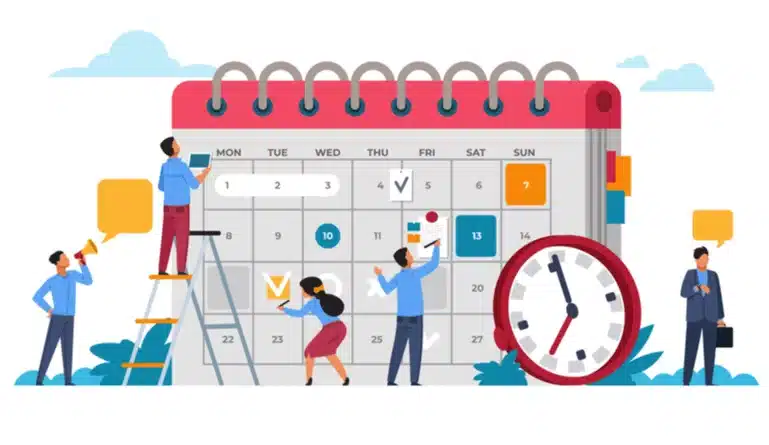When I initially started out in media planning, I was very overwhelmed by the number of options and techniques available. My campaigns improved significantly after I developed a structured approach. In this post, I’ll lead you through the steps to creating a successful media plan, including insights that most websites overlook.
What is a Media Plan?
Now that you’ve learned what media planning is and what the career landscape will be like in 2022, let’s look at how media plans might aid businesses. A media plan specifies the audiences a marketing message will target, the channels to be employed, and the delivery schedule.
Your media plan should include the following components:
- Goals & KPIs: How will you measure advertising campaign success?
- Budget: How much media spend do you have available, and how will you allocate it?
- Audience targeting: What are the aims and issues of the individuals you want to reach, and where (and when) do they spend their time online?
- Messaging: What are the primary themes in the media material, and how will they influence the types of content you create?
- Scheduling: Based on audience analytics, how frequently and when will the messaging appear across channels?
- Media mix: Using audience information, what channels will you employ to boost advertising reach, such as social media platforms, blog content, email marketing, paid ads, earned media (news mentions and backlinks), and conventional media?
Types of Media Planning
To develop an efficient media plan for your brand, you must first determine which types of media (traditional or digital) would be most cost-effective and generate revenue.
When creating a media plan, three major categories of media are considered:
#1. Paid Media
Paid media is advertising that results from sponsored placement by a brand. This encompasses pay-per-click advertising, display adverts, and sponsored content. This is the most typical technique for brands to increase awareness and sales.
#2. Owned Media
Owned media refers to brand-owned content, such as blog entries and social media profiles. You can boost client reach and brand exposure by using more of the company’s owned media.
#3. Earned Media
Earned media is the publicity that a brand receives from sources other than its own firm. Customer reviews, media attention, and word-of-mouth are all examples of earned media. This type of media is useful since it frequently originates directly from customers. This feedback can also assist enhance the quality of the product or service you provide.
By comparing the costs and benefits of each platform, your firm may choose which resources and media formats will work best in your media plan.
The Benefits of a Media Plan
Creating a media plan can help a firm in several ways, including:
- Getting to know your audience better
- Communicating with your audience more effectively
- Systematizing your marketing activities.
- Monitor campaign activity.
- Optimizing campaign performance.
- Keeping up with the current media trends.
- Driving overall business goals, from expanding your customer base to increasing income.
How to Develop an Effective Media Plan
Developing an effective media plan is critical to any marketing strategy. A well-planned media strategy ensures that your message reaches the right people at the right time, optimizing your return on investment (ROI). According to Statista, organizations that apply strategic media planning experience an average 30% ROI improvement. Here are ten steps to help you develop an effective media plan.
#1. Define campaign goals and KPIs
To get outcomes, begin by outlining your campaign’s objectives and key performance indicators (KPIs). Align your campaign goals with your company’s objectives, such as raising brand awareness or driving sales. Examples of campaign aims are:
- Increase brand awareness among the target population by 25% to 40% in six months.
- Achieve a 30% increase in online sales of the flagship product in the first quarter over the prior year.
Within six months, generate 400 or more qualified leads for a forthcoming product launch.
Choose KPIs based on your aims. Keep track of impressions and ad impression share to improve brand recognition. For online sales, keep track of product reviews and click-through rates on the product page. For lead generation, consider cost-per-acquisition and click-through rates for product demos.
Use your KPIs to track progress and, if necessary, change your media plan.
#2. Identify your target audience
Before developing advertising, determine your target audience to guarantee that your campaign reaches individuals who are most likely to be interested in your product, service, or information. Define your audience with a combination of:
- Demographics (e.g., gender and age)
- Socioeconomics (e.g., educational level, employment situation)
- Media preferences (e.g., blogs visited, applications used)
- Interests
- Other qualities.
Your target audience can be representative of your entire audience, a small niche, or a new market. To better understand your clients, use technologies such as Google Analytics, which provides insights on age, gender, and location.
You may delve even deeper with technologies like Semrush’s Audience Intelligence app, which offers crucial insights into numerous social consumer segments. This tool allows you to better identify your target demographic and target them more effectively. Each Audience Intelligence report has nine parts of detailed data: demographics, socioeconomics, influencers and brands, interests, media affinity, content, personality, buying attitude, and online habits.
The software also includes a comparison baseline for each audience data point. Compare this value to the national or global average. Alternatively, use the baseline to uncover trends specific to your audience.
#3. Perform competitive research
Conducting competitive research gives you a substantial advantage by understanding and outperforming your competitors. Here’s how to tackle it:
1. Define your research objectives
Align your research with the campaign’s objectives and KPIs. Key areas to investigate are:
- Advertising placements
- Average Spend
- Audience Segments
- Estimated impressions.
- Media channels and types used.
- Share of voice.
2. Analyze competitor strategies
Examine the ad formats used by competitors in social media campaigns (for example, reels, images, carousels, and videos). Additionally, analyze:
- Social media platforms.
- Posting schedules.
- hashtags
- Caption lengths.
- Influencer collaborations.
Understanding competitors’ techniques allows you to make better selections and guarantees that your media plan stands out.
3. Use Competitive Research Tools
AdClarity from the Semrush App Centre improves competitive research. Analyze digital campaigns to discover top performers across publications, advertisers, ad networks, and agencies. For example, search for a product-related term to see top advertising and learn about audience interactions.
You may also utilize competitive intelligence to define your ad creative and placement by browsing the app’s social ad kinds and video placements used by advertisers and publishers.
Knowing more about your competitors enables you to benchmark against them and make more lucrative judgments, ensuring that your media plan succeeds.
#4. Set a budget
Trying to decide how to best divide monies among channels? Check out the statistics.
The correct budget will provide the desired outcomes and make your advertising money work for you. Understanding market patterns helps to avoid guesswork. Use data from recent benchmark studies to inform your budget allocation. Debating which platforms to invest in? Make informed judgments by reviewing each platform’s average monthly ad spend allocation.
#5. Determine your media mix
Choose your media mix, which includes both media and money allocation for your ad campaign.
This is made easier by your previous competitor research, ad spending benchmark data, and insights into the tastes and behaviors of your target audience. Use this information to determine which channels will assist you achieve your goals.
For example, a media mix for a B2B corporation promoting a webinar may look like:
- Social media (60% of the budget), focusing on LinkedIn ads.
- Online video (20% of the budget), focusing on YouTube’s mid-roll commercials
- Display advertising (20% of the budget), with an emphasis on B2B transactions
Consider the actions you want your target audience to take when determining your media mix, and invest your budget accordingly. Use tools like AdClarity to get an overview of your competitors’ display, video, and social ad distribution.
#6. Develop a media strategy
Your industry and campaign goals will determine how you develop your media strategy. Here are a few tips to help you:
Choose Your Media Assets: Select the proper ad types for each platform, such as banner advertisements, lightbox displays, static graphics, carousels, or movies. Make these decisions based on your target audience’s media preferences and behavioral trends.
Ad Placement: Place your advertising strategically on each channel, based on your previous study.
Pro Tip: Use AdClarity to examine ad placement and performance on individual sites or apps. This allows you to compare results and improve your strategy. For example, if you use display ads, conduct research on display ad placements for relevant publications.
If you plan to run a video ad on YouTube, utilize AdClarity to identify the top YouTube channels to consider.
If your ad is running on social media, the “Social networks” widget in AdClarity displays an analysis of a particular advertiser domain on the social channel.
Ad Creative: Work with copywriters and designers to develop engaging imagery, design, and content. Ensure that your ad is visually appealing to your target audience and meets the platform’s criteria. Consistent message is critical.
Media Types: Achieve your goals by using paid, owned, and earned media. For example, to boost reviews (earned media), provide assets and messages that encourage consumer feedback.
#7. Create a media schedule
Create a media schedule to determine when and how frequently your target demographic will see your advertisements. Engage with media owners to better understand the available inventory. Create a timeline for your media plan, including media flight and budget. Analyze competitor and publisher patterns to determine the best time to launch a campaign.
However, keep in mind that your campaign objectives will have a significant impact on your media flight. For example, if you want to generate 300 leads in three months, you wouldn’t choose a six-month media flight, right? Right.
You’ll also need to decide how frequently your ad or ad campaign should appear in front of your target demographic. Our suggestion? Plan ahead of time to account for future changes.
Media Planning Templates
There are numerous media planning templates available online, which you may purchase or download for free. The benefit of employing media planning templates is that you can adjust and tailor them to your company’s individual needs and objectives.
In any case, how you implement and use media planning templates will be specific to your company and needs, so don’t be hesitant to change your templates as your goals change or your audience increases.
Types of Media Planning Templates
Here are some common media creation and planning templates to get you started. Use one or several, depending on your needs:
- Use the Media Planning Template to visually organize paid media efforts and expenses.
- Social Media Strategy Template: Align your media content with your target audience to add commercial value.
- Social Media Calendar Template: Plan your social media updates in a straightforward, coordinated manner.
- Editorial Calendar Template: Schedule and optimize all marketing content, including as blogs, social media postings, and campaigns.
- Blog Post Template: Easily create entertaining, relevant, and SEO-friendly blog material.
- Ebook Design Template: Create professional-looking ebooks rapidly.
- Infographic Template: Create personalized data presentations in PowerPoint or Illustrator.
- Analytics and Reporting Template: Simplify data collection, organization, and sharing in Excel, PowerPoint, or Google Drive.
- Budget Template: Use Excel or Google Sheets to manage and review your expenses and budgets.
- Advertising Template: Create and manage advertising campaigns that convert audience members into leads and customers.
Free Paid Media Template
Track and organize your media planning and purchasing with this free template:
- Plan paid media placements.
- Calculate total spend easily.
- Evaluate performance and revenues.
Media Plan Examples
Implementing media plans can be difficult. Here are several instances that use linked templates for clarity.
- Social Media Plans
Focus on platforms where your clients are active. If you’re in the exploration stage, try out different platforms to see what works best.
- Blogging Media Plan
Keeping track of how frequently you publish your blog content is critical since it allows you to monitor your progress. A blogging media plan can also assist you manage your writers without sending many emails asking about the status of their blog posts.
- PR Media Plan
A PR media plan is unique and rather time-consuming because it must include other organizations. You must also decide on the type of advertisement that will be most effective for your company, the resources required, and the individuals to contact.
In this sample template, I’ll solely cover the outreach and content planning stages.
| ACTIVITY | DESCRIPTION | START DATE | END DATE |
| Guest posts | Promoting our new workout pants | 3rd March 2022 | 3rd June 2022 |
| Press releases in known publications | Promoting our brand in general | 10th July 2022 | 20th December 2022 |
| Newsletters | Send out monthly newsletters every month | 3rd March 2022 | 29th December 2022 |
Overcome Common Media Planning Challenges
Now that you know how to construct a media plan, familiarize yourself with potential roadblocks to avoid (and how to overcome them).
#1. Keep Up with a Changing Media Landscape
The media world is always developing.
Just think about social media! Facebook sold the first paid social media advertisement in 2005. Less than 20 years later, social media ad spending was at $230 billion, with a projected increase to $300 billion by 2024.
There’s always something new as publishers become more creative with ad buying possibilities, new media formats are introduced (such as YouTube Shorts and Instagram Stories), and new platforms like TikTok and BeReel are established.
Maintain an awareness of the shifting media ecosystem to capitalize on new developments. What are our tips? Follow media-specific advertising awards, such as Digiday, to discover what’s winning. Subscribe to industry trade newsletters such as Marketing Brew for the most up-to-date information.
#2. Avoid Media Planning Fatigue with Automated Support
Marketing—particularly media planning—can be exhausting. A poll by the Chartered Institute of Marketing (CIM) found that 52% of marketers are concerned about burnout.
So, how do you minimize unnecessary stress as a marketer and media planner? Define your responsibilities and examine what can be automated; not everything should be done manually.
For example, solutions like Audience Intelligence allow you to conduct extensive audience research in one location (rather than manually scanning channels). In minutes, you can find untapped audiences (rather than relying on guessing) and learn how your target audience interacts with your competition.
Use automation to work smarter and achieve better outcomes.
#3. Integrate media planning into the overall marketing plan.
Do not let your media planning or media staff get siloed.
Instead, ensure that your media plan is consistent with your organization’s overall marketing strategy and that both work together to achieve business objectives.
This cohesiveness will guarantee that all marketing activities are consistent, allowing you to better connect with your target audience.
Key Takeaways
- Set clear, Measurable, and Achievable Goals: Defining clear, measurable, and attainable objectives is critical for driving your media plan.
- Understand Your Audience: Creating thorough buyer personas can help you adjust your strategies more successfully.
- Learn from Competitors: Competitive analysis provides useful information and ideas.
- Choose the Right Channels: Evaluate and pick media channels that will effectively reach your target audience and support your objectives.
- Monitor and Adjust: Track the performance of your campaign regularly and be prepared to make data-driven adjustments.
Conclusion
A winning media strategy requires meticulous planning, strategic thought, and constant optimization. By following these steps, you can create a media plan that not only reaches your target audience but also produces tangible results. How has your media planning changed over time, and what new methods are you interested in trying?
Related Articles
- A Step-by-Step Guide to Planning and Executing a Successful Book Launch
- How to Write The Perfect Media Brief: A Step-by-Step Guide
- Taking a Social Media Break: The Impacts And Benefits
- How to Create a Strong Personal Brand on Social Media
- Social Media Strategy Templates: 10+ Free Social Media Strategy Templates to Help Your Team Save Time






